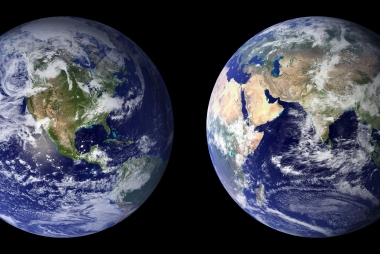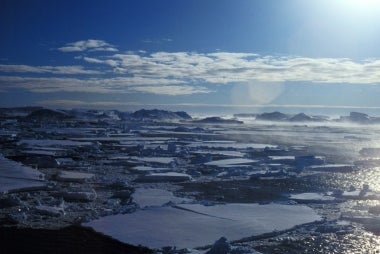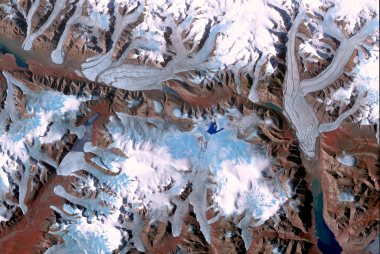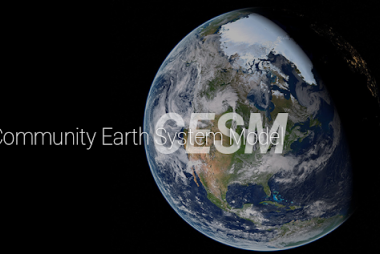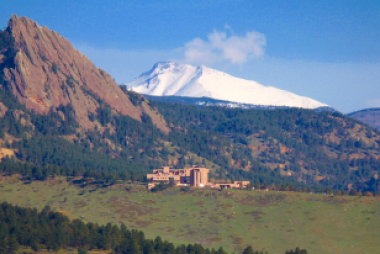May 2024 Newsletter Issue
Welcome to our third quarterly Community Earth System Model (CESM) Newsletter. Want to receive our next newsletter in your inbox? Visit our newsletter page to subscribe and never miss a newsletter.
In this Newsletter:
Chief Scientist Message
CESM Simulations Update
POP will not be supported in upcoming CESM tags
2024 Andrew Slater Award Winner
Upcoming Meetings
CESM Workshop Plenary Speaker Announcement
CESM Workshop Cross-Working Group Sessions
Research Highlights from our Community
Technology Updates
Quick Links
Chief Scientist Message
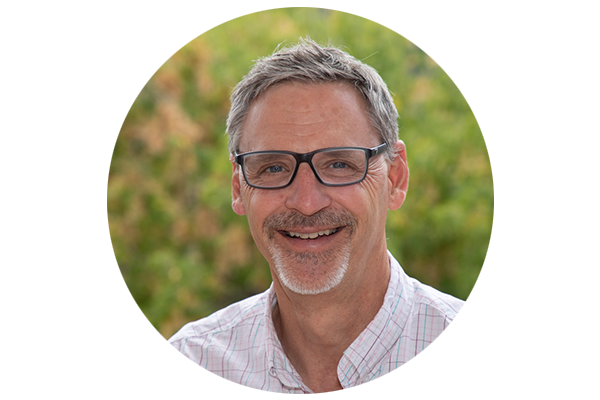
|
We are fast approaching the 29th Annual CESM Workshop (June 10-12)! As you will see below, we have put together what I think will be a stimulating program with inspiring and informative plenary speakers, presentations from the Distinguished Achievement and graduate student award winners, four cross-working group sessions, and a full slate of Working Group meetings. As COVID continues to fade into the rear-view mirror, it feels surprising that this is just our 2nd post-COVID in person CESM Workshop. Here at NSF NCAR, we are looking forward to the opportunity to engage with the CESM community, to see old friends, to meet new students and postdocs, to foster new collaborations, and to explore new directions for CESM. The deadline for in person registration is May 31!
The workshop comes at an exciting and busy time as we are in the final stages of code implementation prior to a ‘freeze’ of the science code as we work towards CESM3. I put the term ‘freeze’ in quotes because we know that there is still a lot of work to do to produce a useful model and additional code changes may be required. Nonetheless, this is an important step along the path towards the creation and release of CESM3, a modeling framework that we hope will usher in many new science opportunities. I am highly appreciative of all the work that has gone in by the software engineering and science teams to get us to this point.
The CESM Workshop, for me at least, also represents the start of summer (☀️) and that means ‘visitor season’ when NCAR CESM staff will be hosting researchers from around the world to work together to apply and develop CESM. It is also the time of year when the CESM tutorial happens (Aug 5-9 this year), another great opportunity to educate the next generation of scientists about Earth System modeling and the potential of CESM and CESM data to advance their research. Many NCAR staff are hard at work prepping for the tutorial.
Finally, I want to express my appreciation to the CESM Advisory Board, which met with CESM leadership in late January, and the NSF NCAR Climate and Global Dynamics (CGD) Lab Advisory Panel, which met with CGD leadership earlier this month. From both of these groups, we received insightful questions, feedback, and advice on the CESM Project that will be very helpful as we continue to negotiate our way through the rapidly changing Earth System modeling and climate change and prediction science environment. Both groups recognize the challenges ahead but were also appreciative of the ongoing contribution of CESM towards advancing the state of Earth System science. I am sure these challenges and opportunities will be a focus of many conversations at the CESM Workshop and I look forward to engaging with everyone on these topics there and at other venues.
CESM Simulations Update
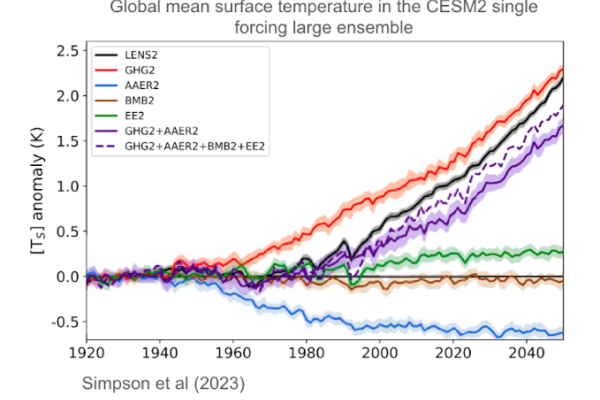
Caption
|
The CESM Project produces many large community simulations with the latest model versions that are freely available to the broader community either for analysis or to serve as baselines for any new perturbation experiments. These include long pre-industrial controls both with coupled and with prescribed climatological or time varying sea surface temperatures, large ensembles, long AMIP-type simulations that are kept relatively up-to-date, large ensembles, single forcing large ensembles, pacemaker experiments, initialized seasonal to multi-decadal prediction ensembles, and paleoclimate simulations. Catalogs of these community simulations are provided by the CVCWG, ESPWG, and PaleoWG, which includes methods by which the data can be accessed. Please consider joining the mailing lists for these working groups to be kept up to date with the latest datasets as they become available.
POP will not be supported in upcoming CESM tags
Starting with the new CESM tag (3_0_beta01), POP2 will no longer be supported. However, older CESM tags and releases will continue to include POP2. If you have projects that plan to use POP2 within CESM3, please contact the OMWG co-chairs (Gustavo Marques and Ian Grooms) to work out a solution.
2024 Andrew Slater Award Winner
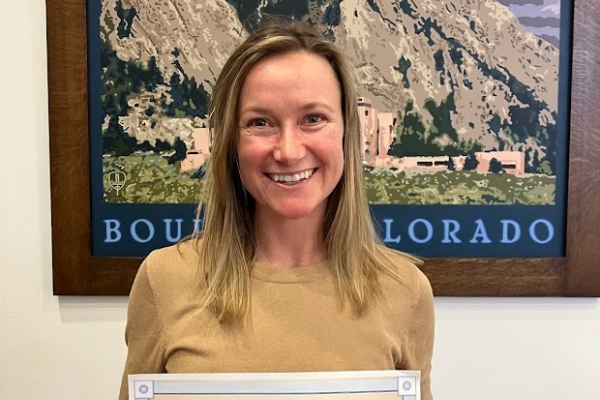
|
At our February workshop, the CESM Land Model Working Group (LWMG) recognized Linnia Hawkins as the 2024 Andrew Slater Award winner. Drew Slater was a key member of the LMWG community who brought a deep dedication, understanding, and joy to his research, which he shared with everyone around him. Linnia’s initiative and leadership in the land model parameter perturbation experiment (PPE) demonstrate a meaningful contribution to the LMWG that addresses model biases and accelerates the pace of development. Linnia’s research uses machine learning for systematic parameter calibration, which is reshaping how we are able to calibrate model parameters and quantify uncertainty in terrestrial processes. Linnia also demonstrates high engagement with the LMWG and CESM communities. She is helping to lead monthly discussions related to the PPE experiment in the land model and is also coordinating a broader Parameter Estimation Interest Group that aims to foster discussions, collaborations, and advance methodologies across the model components and modeling centers. Linnia is a gifted communicator who graciously shares her expertise with teammates in the LMWG and the wider CESM project. Since 2018, the Slater Award has been given to graduate students and postdocs who make meaningful contributions to the LMWG. Linnia has earned her place in this distinguished group.
Upcoming Meetings
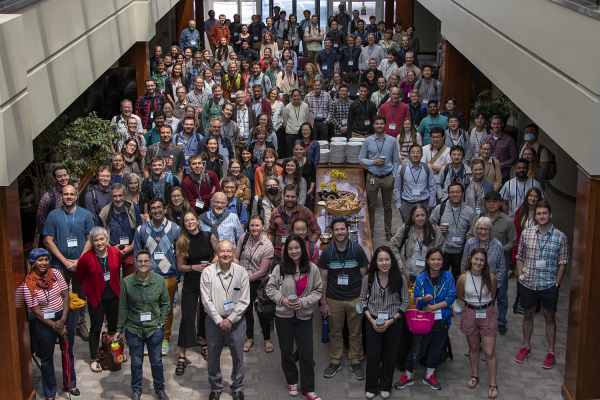
|
CESM Workshop 2024
The 29th Annual CESM Workshop will be held from June 10th to June 13th, 2024 in Boulder, CO.
The CESM Workshop will begin with a full-day schedule on Monday 10 June 2024. The day will include presentations on the state of the CESM, presentations by this year's award recipients, and plenary presentations followed by CESM Working Group Meetings in the afternoon and an interactive poster session.
On 11-12 June 2024, Working Groups Meetings continue and there will be four cross-working group sessions on Tipping Points, Harnessing Machine Learning for CESM: Innovation and integration, Sea Level Science, and High/Ultra-high resolution CESM (see below for more details). These sessions are designed to share information and encourage discussion and collaboration.
The agenda and registration for in person, hybrid, or remote participation can be found online.
CESM Workshop Plenary Speaker Announcement
Jane Mulcahy -“UKESM2 development pathway, progress and plans towards CMIP7”
Jane is a senior research scientist working in the joint NERC-Met Office ESM Core Development Group. Her current work focuses on improving the simulation of aerosols and their feedbacks within the fully coupled UKESM model. Jane is currently implementing the state-of-the-art aerosol and chemistry model, UKCA-mode in UKESM replacing the older CLASSIC scheme used in HadGEM2-ES. In collaboration with UKCA scientists across the UK academic community, including the University of Leeds, University of Oxford, University of Reading, and University of Cambridge she works on the development and evaluation of the new aerosol scheme in the Unified Model, evaluating the impact of the new aerosol scheme on the physical model and eventually in the fully coupled system.
Maria Rugenstein -“How the Good and the Bad conspire to the Ugly: trends of surface temperatures and TOA radiation in climate models and observations"
Since 2020, Maria has been an assistant professor for climate dynamics at the Department of Atmospheric Science at Colorado State University in Fort Collins. Maria studied at ETH Zürich, completed her Master's research at Princeton University/GFDL, and dived into paleoclimate research for two years in Utrecht, before completing her PhD in Zürich with visits to Stanford University and the Carnegie Institute for Global Ecology and a PostDoc at MPI in Hamburg. Maria coordinated a model intercomparison of millennia long simulations of global coupled Atmosphere-Ocean Models, LongRunMIP, together with Jonah Bloch-Johnson, and initiated the Green's Function Model Intercomparison, lead by Jonah.
Verokina Eyring - "Understanding and Modelling the Earth System with Machine Learning"
Veronika Eyring is Head of the Earth System Model Evaluation and Analysis Department at the German Aerospace Center (DLR) Institute of Atmospheric Physics and Professor of Climate Modelling at the University of Bremen. Veronika's research focuses on improving climate models and projections with machine learning and spaceborne Earth observations for actionable climate science and technology assessments in aeronautics, space, transport, and energy research. She has authored many peer-reviewed journal articles and has contributed to the Intergovernmental Panel on Climate Change (IPCC) climate assessments for many years. Veronika has also been involved in the World Climate Research Programme (WCRP). Veronika received the German Research Foundation (DFG) Gottfried Wilhelm Leibniz Prize in 2021. In 2024, the Technical University of Munich (TUM) appointed her as TUM Distinguished Affiliated Professor. She also maintains a strong collaboration with the National Center for Atmospheric Research (NCAR, Boulder, CO, USA) as an Affiliate Scientist.
CESM Workshop Cross-Working Group Sessions
Tuesday, June 11, 2024, 8:30 - 10:30 AM
Session I : Tipping Points
Organizers: Gokhan Danabasoglu and Bette Otto-Bliesner (NSF NCAR)
In recent years, interest in evaluating risks associated with crossing individual and/or compound tipping points within the Earth system in the presence of anthropogenic warming has significantly increased. Such tipping points include both reversible and irreversible changes in high-latitude permafrost, Atlantic meridional overturning circulation, Greenland and Antarctic ice sheets, and boreal and tropical forests. There are two proposed efforts within the CMIP7 framework to define common protocols to i) obtain such events and assess any related uncertainties, reversibility/recovery aspects, etc. under the Tipping Point Model Intercomparison Project (TIPMIP) effort; and ii) investigate extreme outcomes, impacts, risks, etc. associated with such events, assuming that they have already happened, under a complementary project, the What If Modeling Intercomparison Project (WhatIfMIP). The goals of this cross-WG session are to introduce these intercomparison projects along with several other related international (mostly European) efforts; review related national efforts; and gauge the interest of the community regarding participation in these efforts. The session will have invited presentations followed by a discussion.
Tuesday, June 11, 2024, 8:30 - 10:30 AM
Session II: Harnessing Machine Learning for CESM: Innovation and Integration
Organizers: Kirsten Mayer and Will Chapman(NSF NCAR), Linnia Hawkins and Wayne Chuang (Columbia University)
This session aims to explore ongoing machine learning (ML) applications within the Community Earth System Model (CESM), acknowledging a future CESM that may increasingly incorporate ML in the coming years. As CESM evolves, leveraging ML offers opportunities to enhance model performance through improved parameterizations, automated parameter estimation, real-time bias correction, and beyond. This cross-working group session will serve as a nexus for sharing innovations, discussing challenges, and charting the course for incorporating ML into CESM science. Further, the session will foster dialogue among experts leading ML-driven projects, encouraging a cohesive approach towards the advancement of CESM.
We encourage abstract submissions using ML for both model development and the analysis of CESM simulations.
Tuesday, June 11, 2024, 3:30 - 5:30 PM
Session III: Sea Level Science
Organizers: Gunter Leguy and Monica Morrison (NSF NCAR) and Miren Vizcaino (GRS, Delft University of Technology)
This session will provide an opportunity to review the state of sea level science and discuss opportunities for scientific applications using CESM on topics including: regional and global sea level rise; coastal management; adequate and responsible communication between practitioners and scientists; using science to inform climate adaptation and resilience decisions and implications for just responses to SLR.Organizers:
Tuesday, June 11, 2024, 3:30 - 5:30 PM
Session IV: High/Ultra-High Resolution CESM
Organizers: Adam Herrington (NSF NCAR) and Christiane Jablonowski (University of Michigan)
This cross-working group session will discuss ongoing and future pathways to foster high- and ultra-high-resolution modeling capabilities for CESM. Special attention will be paid to cloud-permitting and weather-system-resolving model configurations with grid spacings between 3-25 km. The science, software infrastructure, and hardware challenges for high-resolution applications will be addressed.
Research Highlights from Our Community
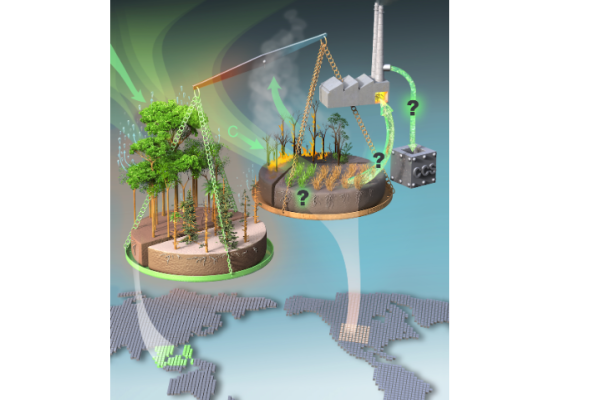
Caption
Figure Caption: Cheng et al. (2024) compared two land-based global warming mitigation strategies, depicted here as weighed in the pans of a metaphorical balance. Re/afforestation (left) is most successful in the tropics, where planted trees perform well as a carbon sink and transpire moisture that provides regional cooling. However, outside of the tropics, this approach may fail wherever trees grow poorly. Bioenergy crops (right) can be used instead of fossil fuels to produce energy, and if the carbon is sequestered by industrial Carbon Capture and Storage (CCS) methods, then this could be an effective means of carbon dioxide removal. However, crop yield, biofuel conversion efficiency, and CCS technology effectiveness all carry significant uncertainties, as indicated by the three question marks. The global map at bottom shows each scenario connected to an example of a favorable regional deployment (Southeast Asia vs. Central US) as per the study's suggestion that land use planning should consider mitigation that is the best fit with regional factors. Image illustrated by Victor O. Leshyk. |
Robust Polar Amplification in Ice-Free Climates Relies on Ocean Heat Transport and Cloud Radiative Effects
Mark R. England and Nicole Feldl
In this study, we explored whether polar amplification occurs without sea ice and the role climatological ocean heat transport plays. To investigate this, we ran a suite of targeted experiments in the slab ocean aquaplanet configuration of CESM2-CAM6 with different profiles of prescribed ocean heat transport, which are invariant under CO2 quadrupling. In simulations without climatological ocean heat transport, polar amplification does not occur. In contrast, in simulations with climatological ocean heat transport, robust polar amplification occurs in all seasons. We demonstrate that shortwave cloud radiative feedbacks can explain the divergent polar climate responses simulated by CESM2-CAM6. Targeted cloud locking experiments in the zero ocean heat transport simulations are able to reproduce the polar amplification of the climatological ocean heat transport simulations, solely by prescribing high-latitude cloud radiative feedbacks. We conclude that polar amplification in ice-free climates is underpinned by ocean-atmosphere coupling, through a less negative high latitude shortwave cloud radiative feedback that facilitates enhanced polar warming. In addition to reconciling previous disparities, these results have important implications for interpreting past equable climates and climate projections under high-emissions scenarios. This publication would not have been possible without the CESM model hierarchy and the fantastic support offered by the CESM community.
Hacking planet Earth will not save us from ourselves
Dr. Kevin E Trenberth
A number of geoengineering methods have been proposed as a way to cool our warming planet but the problem is the increasing amount of carbon dioxide and other greenhouse gases in the atmosphere – the pressure instead must increase to cut emissions and use of fossil fuels.
A bioenergy-focused versus a reforestation-focused mitigation pathway yields disparate carbon storage and climate responses
Yanyan Cheng, David M. Lawrence, Ming Pan, Baoqing Zhang, Neal T. Graham Peter J. Lawrence, Zhongfang Liu, and Xiaogang He
Cheng et al. (2024) compare CESM2 simulations that limit global warming to ~2 °C, but reach the CO2 targets through different land-based carbon dioxide removal strategies, one primarily driven by bioenergy expansion and one primarily driven by re/afforestation. While the re/afforestation-focused scenario shows strong CO2 removal with lower uncertainties, CESM2 predicts that it could lead to a warmer regional climate than the bioenergy expansion–focused scenario, especially in regions unfavorable for tree growth. Despite the global relative cooling effect, the bioenergy expansion–focused approach produces shifts in regional warming hotspots, potentially amplifying summer temperatures in vulnerable regions such as Central Africa and Southeast Asia. This study highlights the importance of carefully locating suitable re/afforestation and bioenergy expansion regions for achieving intended climate mitigation outcomes.
Chemistry-albedo feedbacks offset up to a third of forestation’s CO2 removal benefits
James Weber, James A. King, Nathan Luke Abraham, Daniel P. Grosvenor, Christopher J. Smith, Youngsub Matthew Shin, Peter Lawrence, Stephanie Roe, David J. Beerling, AND Maria Val Martin
Editor's summary: Forestation is considered a good way to sequester atmospheric carbon dioxide and cool climate, but its impact on climate is more complex than just its effects through carbon capture. Weber et al. explored the impacts of forestation on climate by quantifying its influence on surface albedo and atmospheric composition. Using CESM2 and UKESM1 simulations with interactive chemistry, they found that the combination of decreased reflection from newly planted forests and increased aerosol scattering of incident sunlight driven by higher BVOC emissions offsets about one-third of the cooling by carbon dioxide removal that forestation produces.
Technology Updates
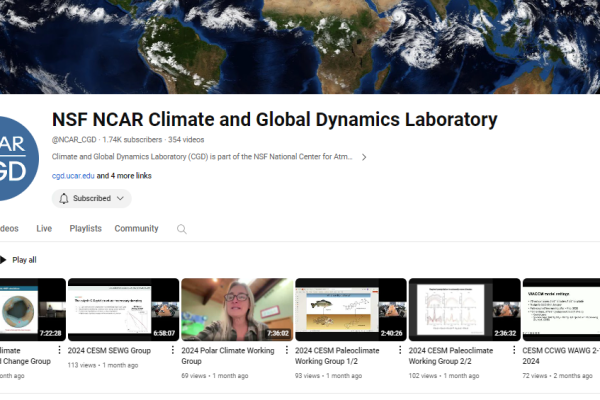
|
Google Groups Update:
Our mailman email lists have been renamed and updated, for more information and to sign up for the new groups please visit this webpage to learn more.
CGD Youtube Channel Subscription:
The CGD YouTube channel frequently streams and posts CESM workshop and tutorial videos, seminars, etc. If you want to follow along, visit our YouTube page and select Subscribe at the top of the page.
Quick Links
CGD X Account
CGD Youtube Channel
CESM User Support Forum
CVCWG Simulations
Simpler Models Information
Thanks for reading this CESM Newsletter! Expect to see the next one in Summer of 2024. Please send potential Newsletter items to Elizabeth Faircloth.
